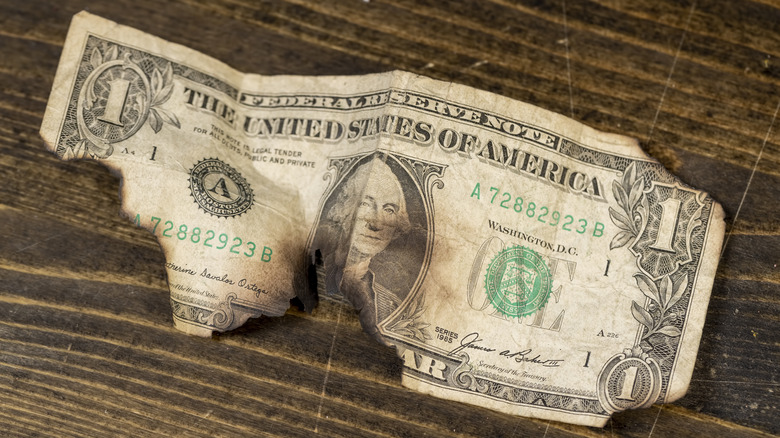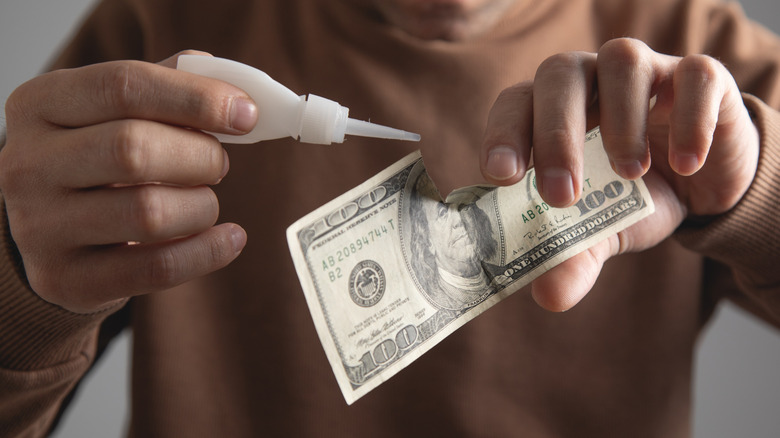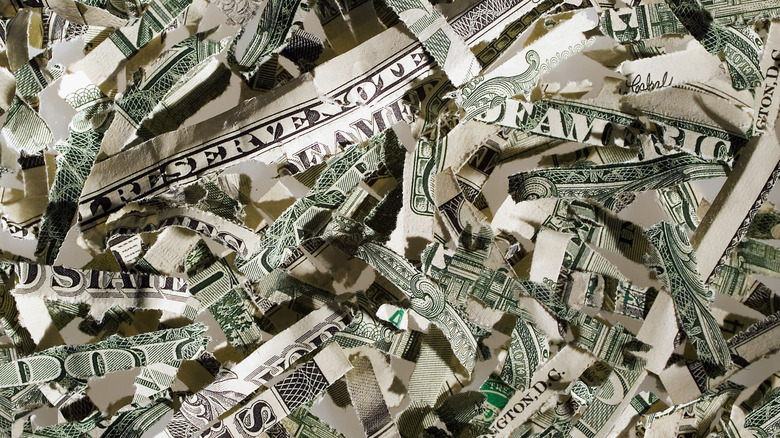Why Does The Federal Reserve Shred Currency And Where Does It Go?
We may receive a commission on purchases made from links.
Perhaps you've seen the "Where's George?" stamp on $1 bills. Basically, you can check the wheresgeorge.com website and enter the serial number to track your bill's journey. You can add information about how you obtained and are using it. The website has data listed for roughly 330 million individual bills. One $1 note even had locations listed over a 20-year period. This is impressive considering the rough treatment most cash receives and the fact that the average lifespan of U.S. paper money ($1 bill to be exact) is typically 7.2 years, according to the Federal Reserve.
But maybe you've noticed that some of your 'Where's George' bills disappear from circulation. Chances are, it got too damaged to spend. When a piece of U.S. currency reaches the end of its useful lifespan, what happens to it? Bills that are in poor condition or feature an older design are shredded at a facility. They can then be recycled, burned to make electricity, or sold as souvenirs.
The Federal Reserve receives bills from banks across the United States. Banks send their excess cash on hand to the Federal Reserve, which reimburses the banks with new bills. The Federal Reserve uses machines to examine each of the notes. It verifies that the bank accurately recorded the bill's value, determines whether it's genuine (and not counterfeit), and determines whether it remains "fit for commerce." Any note that has too much damage or is too soiled would be shredded on the spot. Learn more about how the Federal Reserve determines when to shred bills and what happens next.
When does currency get shredded, and how do you redeem damaged currency?
How do the Federal Reserve's machines decide when it's time to take a bill out of circulation and shred it? Bills that have rips, holes, tears, tape repairs, or writing on them usually come out of circulation. If it's a $100 bill with a 3D security ribbon embedded, and if that ribbon is missing, it must be taken out of circulation. Such notes go directly for shredding, and approximately, more than 5,000 tons of damaged currency are shredded each year. The Federal Reserve estimates that about 15% of $1 bills it examines are shredded, while 5% to 10% of $50 or $100 denomination bills are shredded.
If you have damaged currency at your home or business, you have an option to try to redeem it through the Bureau of Engraving & Printing's Mutilated Currency Division or a local bank. If your notes are more than three-quarters intact or you have two halves of a bill, you can redeem them at your local bank. More heavily damaged bills may need to go through the BEP for review. You can redeem currency that's heavily damaged from fire, water, or chemical exposure, animal damage, or deterioration from burying, where no more than half of the original bill is in good shape. If it is more than 50% identifiable with the security features intact, you also should be able to redeem the bill.
What happens to the shredded currency from the Federal Reserve?
Many years ago, all shredded currency ended up as waste in a landfill. Now, the Federal Reserve attempts to recycle as much shredded currency as possible, recycling an estimated 86% annually. Recycling the bills might seem challenging because U.S. cash isn't made out of what you think it is. It's not paper; instead, it's called substrate, which is a material consisting of plant fibers designed for banknotes. U.S. bills consist of 25% linen and 75% cotton. The BEP is the only entity that can legally possess this exact type of substrate.
Even though it's substrate and not paper, shredded cash is reused in many different ways. It's burned in eco-friendly power plants in Los Angeles and San Francisco. In New Orleans, the shredded materials are used as compost for community gardens. In Salt Lake City, a company burns the currency and then uses it to cure cement poured in the area. Considering the cost to make a $1 bill is 3.2 cents (according to the Federal Reserve), reuse is an option to recover some of the manufacturing expense.
People who visit the BEP visitor centers in Washington, D.C., or Fort Worth, Texas, have the option of buying prepackaged bags of shredded currency as souvenirs. You can also buy bags of shredded money at various retailers like Amazon, where a bag costs $9.


